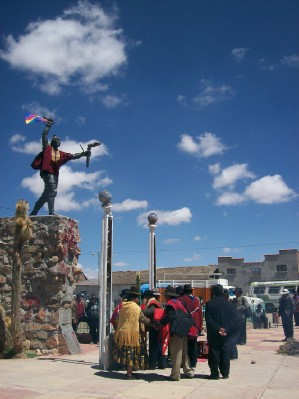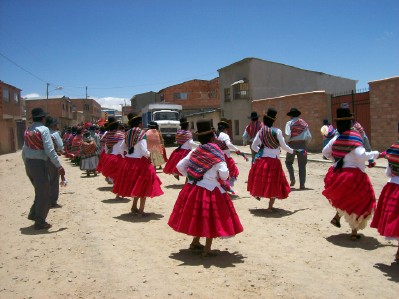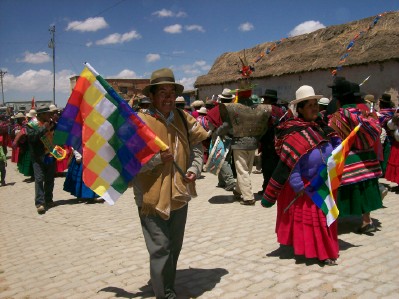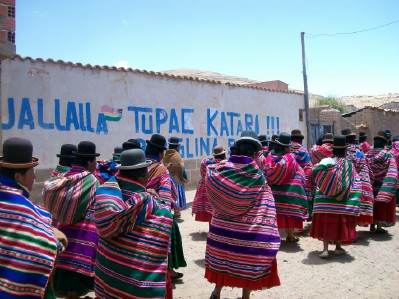November 14 marked a milestone in the history of the Andean region as it was 229 years since the indigenous leader Tupak Katari [1] was sacrificed.
Between 1720 – 1730, anti-colonial sentiment was growing in the Andean region and indigenous people rose up in defiance of the Spanish authorities. Around 1780, a series of riots erupted around the high plateau areas of the Andes, signifying the discontent of the indigenous people. In 1781, Tupac Katari led a large-scale uprising of the indigenous people laying siege to the city centre of La Paz which, at the time, was occupied by Spanish settlements. This anti-colonial movement symbolised an affront to the established power and as a result, Tupac Katari was captured before being killed.
As a mark of remembrance of the indigenous leader, numerous activities have taken place across local towns and villages. On November 14, the anniversary of the death of Tupac Katari was marked by an event held in the central square of Peñas located within the Batallas suburb of La Paz. This square is the exact same spot where Tupac Katari had his limbs tied to four horses before they were brutally chopped off in 1781. Similarly, Radio Atipiri [3] [es] highlights in their blog the remembrance events that took place [4] [es] in a town in the Aroma province of La Paz last Sunday.
En el municipio de Ayo Ayo, en el ayllu (conjunto de familias) Sullcavi, en la comunidad Lacaya (Lugar de nacimiento de Julián Apaza), los habitantes y las autoridades originarias realizaron actos rituales de agradecimiento a la lucha emancipadora que promovió el líder indígena Tupak Katari.
Levantaron ofrendas hacia los cuatro lados, donde dejaron abandonado sus extremidades los españoles, después de descuartizarlo a Julián Apaza, en la localidad de Peñas.
In the Lacaya neighbourhood of Ayo Ayo, the native Sullcavi community performed thanksgiving rituals in remembrance of the indigenous leader responsible for their liberation, Tupac Katari.
They offered up gifts to the four sides where the Spaniards left Katari's limbs after they were chopped off in the suburb of Peñas.
The festival of remembrance that took place in the town of Ayo Ayo commenced on November 12 and lasted right through until November 15. On the final day, local people from the various communities of the town gathered together in the main square from the early hours of the morning together with representatives from the local indigenous council. This day was also marked by a minute's silence followed by a ritual ceremony. By mid-morning, the crowds were then gathered together in the area from where the remembrance procession would set off.
 [5]
[5]
In their blog, Radio Atipiri [6] [es] discusses the remembrance activities that took place on Monday November 15.
A la localidad de Ayo Ayo, llegaron varias delegaciones de las Centrales Agrarias de las 20 provincias del Departamento La Paz, trayendo consigo la música autóctona y la vestimenta de cada comunidad y ayllu.
Las comunidades se concentraron sobre la carretera La Paz Oruro y el cruce del municipio de Ayo Ayo. Cerca de las 10:50 a.m. partió la marcha de recordación hacia plaza centro de Tupak Katari, donde se desarrolló el desfile de recordación del descuartizamiento y la muerte de Julián Apaza (Tupak Katari).
Los habitantes de las comunidades llegaron uniformados, por ejemplo las mujeres lucían mantas color café, chompas blancas, sombreros negros, y pollera bayeta color rojo. Los Mallkus (autoridad originaria) llegaron con sus ponchos wayrurus (rojo y negro), el lazo de autoridad, sombrero negro y una chalina café.
Residents from local communities came dressed in traditional costume. The women wore brown-coloured cotton skirts, white-coloured traditional Andean sweaters, black hats and red skirts. The Mallkus (representatives from the indigenous councils) wore red and black coloured ponchos (locally known as wayrurus), sashes, black hats and brown scarfs.
After having cut off his limbs some 229 years ago, Tupac Katari's killers scattered his arms and legs across different parts of the city of La Paz in the hope that this would warn off any other individuals who were contemplating uprising. Katari's heart was taken to the El Alto suburb. Cambio [10] [es], a Bolivian newspaper, describes the homage below.
La iza de la bandera de los lunes, que tradicionalmente se realiza a las 07:00 de la mañana en la ciudad de El Alto a cargo de autoridades municipales, militares, policiales y vecinos, se convirtió ayer (15 de noviembre) en un emotivo acto de conmemoración del descuartizamiento de Julián Apaza, más conocido como Túpac Katari, donde se presentó el proyecto de Ley por las Rutas de Túpac Katari.
Similarly, on November 19 a festival of music and dance took place on the main roads of El Alto. A meeting is also scheduled to take place on November 26 and 27, organised by the Universidad Indígena Tupak Katar where influential figures from indigenous communities will come together.
Although time has passed, indigenous people in Bolivia continue to hold the words of Tupac Katari at the forefront of their minds – “I will return and be millions”.



